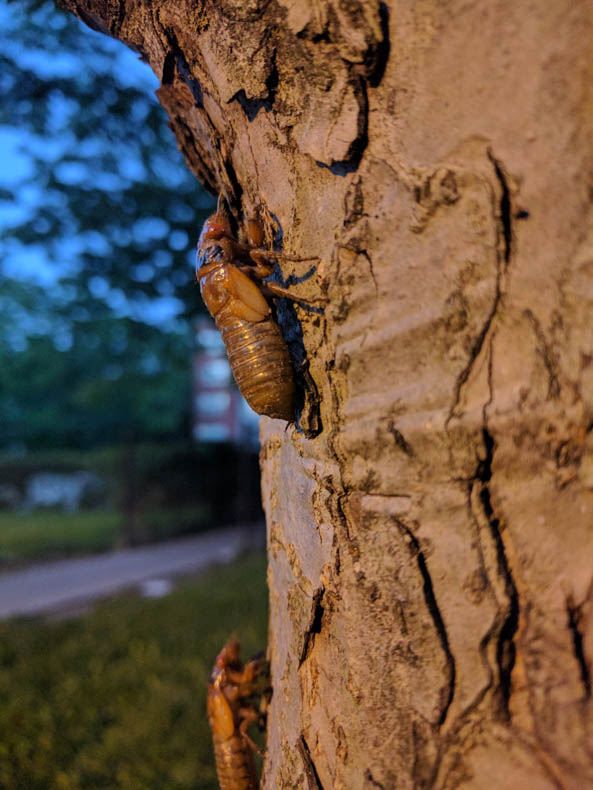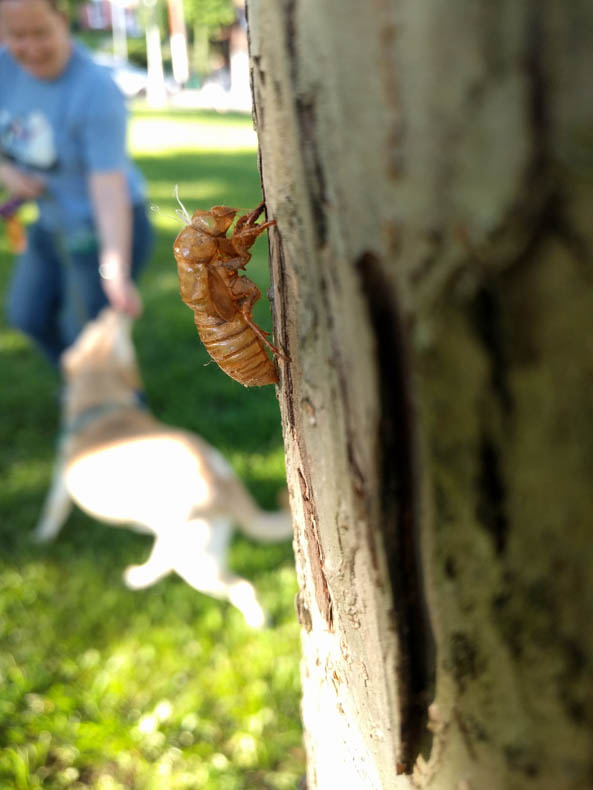
One evening this month I was coming back from the library. The pollen was at its worst, but I was sick of being indoors and thought I’d sit down on the grass in front of my building for a few minutes. I opened up one of my books, then felt guilty about choosing the world of the book over the world around me, closed it, and looked around.
There were buses and people and trees and birds to look at, but I was mesmerized by the grass. It’s not very nice grass, just whatever happens to grow there and to tolerate regular mowing. What amused me was watching it actively recovering from my having walked on it. Sproing! Sproing! One by one a blade would pop back up, marking my trail.
Then I noticed a different movement.
A grass blade would go down, down, then spring up. Through the green leaves and stalks I could see something brown. A beetle? I wondered. Wait, it couldn’t be–a cicada?
17-year cicadas are one of my favorite biological events. Once every 17 years they come out and buzz from the trees for a few weeks, mate, and die. The female lays eggs in twigs. When the eggs hatch, the nymphs fall to the ground and burrow down. They suck sap from roots; they grow and change. And, 17 years later, they emerge to find a mate and die.
The big brood in the DC area is Brood X (it’s a Roman numeral, not a portent of doom), and it’s not due til 2021. But in the previous weeks people had been reporting stragglers–cicadas who come out early, possibly befuddled by climate change. You can read more about the stragglers here.
I watched the cicada hauling itself through the grass. It had just dug its way out of the ground and was doggedly pulling across the landscape. It crawled up a clump of grass that bent slowly, slowly under its weight, then pulled itself past them and they sprang back up. It pulled onward, over the toothy leaves of a dandelion.
This cicada was still just a nymph. Its underground metamorphoses had gotten it to the fifth instar, the last larval form before it turns into an adult. I could see its red eyes and its wings–not usable yet, still tight against its body underneath its clear skin. The next step in its life cycle had to be to get rid of that exoskeleton and release those wings, and as I watched I realized where it was going: straight toward the trunk of a tree. A crabapple, I think, that a few months earlier had been full of fragrant flowers and buzzing bees.
The nymph flailed over obstacles, dragging its huge abdomen behind. It took maybe 15 minutes to cross three feet of grass, but then it got to the bare dirt around the tree and quickly pulled along, left right left right, to the trunk. Its hooked front legs got a grip and it began to climb. When it was about three inches up the trunk, I noticed another wiggle in the grass, and then that one was sprinting to the trunk, too. One front leg then the next swung at the bark, as if the nymphs were climbing with ice axes. The second cicada soon passed the first, climbing higher. A third came out of the grass on the other side of the tree. More grass twitched and a fourth emerged, and a fifth.
As I watched, sitting on the grass, I felt a prickle, just above my collar. Mosquito! I thought and swatted. I connected with something big. The swat turned into a flail and I leapt up, turned around, and stared at the grass around the print I’d left on the ground–and there it was, the cicada that thought I was a good place to shed its exoskeleton.
I love the little critters, but they can keep their ice-axe feet off my neck. I moved away and the nymph turned toward the tree.
After that I stood, moving whenever I noticed another nymph bending its grassy path toward me, trying to avoid stepping on them. One after another reached the dirt patch, then the trunk. They climbed and climbed. When they reached a smooth patch of bark they’d stall, reaching over and over, left, right, left, right, scratch, scratch, scratch, scratch, until a leg caught. Occasionally one fell to the ground and started over.
I’d hoped to see one of them stop and go through its final metamorphosis, but after an hour of watching them climb as the sun set, I gave up and went inside.
The next day, I checked on the tree. The cicadas’ shells clung tight. They’d left their exoskeletons behind, pumped up their wings, and flown off, or been eaten by birds or squirrels.
The 17-year-cicadas are in a genus called Magicicada. It does seem almost like magic to me, or maybe science fiction, the way our timelines line up for just a few weeks, as if we were on planets whose orbits cross only once every 17 years. But we’re all here on the same green and blue planet. They’re doing their thing underground, and we’re doing our thing above, until they emerge and we meet, a cross-species moment of intersection.

Photos: Helen Fields
The times are out of joint when writing like this can’t find a publisher or even a decent audience.
LWON is my publisher! You, Dick Kovar, are my decent audience!
Lovely essay. Time for me to trot out the fact that Bob Dylan write a song about the cicadas after getting an honorary degree at Princeton during the 1970 emergence–which was also the first one I experienced (in Princeton as well). I also saw the 1987 and 2004 events. I hope the confusion doesn’t derail the 2021, which I’ve been looking forward to.
It’s a special person, Mike, who looks forward to a 2021 event that features a gazillion red-eyed bugs. I say this with affection and the knowledge that Helen is likewise special.
Enjoyed the essay! These are the vanguard. I hope we still have a big show to watch in 2021. Brood X came the year my daughter was born. When she was five months old, I put her down in the grass on a blanket at the Y, turned away, and turned back to notice a half dozen cicadas crawling sci-fi movie style toward her.
so when were the 13 yr species out & about? I had always thought that due to the respective species’ “prime numbered” directive they could never intersect and it was evolution’s way of keeping them separate. But 17 and 13 do cross – at 221 (alas I was never that great with the math stuff). So I’m left trying to imagine the cicadic cacophony that ensues upon that blessed?!? day…
Love this and love cicadas–maybe because they exemplify for me how humans can think they control nature, but every 17 years our city and suburban scapes are covered with them in a deluge of irrespressable buggyness. The only time I’ve had true tattoo envy was when my daughter’s daycare teacher got a gorgeous cicada tattoo, with the wings spread out like a butterfly.